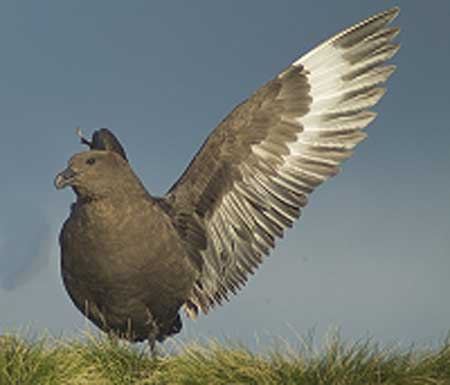
Stercorarius antarcticus (*)
Superregnum: Eukaryota
Cladus: Unikonta
Cladus: Opisthokonta
Cladus: Holozoa
Regnum: Animalia
Subregnum: Eumetazoa
Cladus: Bilateria
Cladus: Nephrozoa
Superphylum: Deuterostomia
Phylum: Chordata
Subphylum: Vertebrata
Infraphylum: Gnathostomata
Megaclassis: Osteichthyes
Cladus: Sarcopterygii
Cladus: Rhipidistia
Cladus: Tetrapodomorpha
Cladus: Eotetrapodiformes
Cladus: Elpistostegalia
Superclassis: Tetrapoda
Cladus: Reptiliomorpha
Cladus: Amniota
Classis: Reptilia
Cladus: Eureptilia
Cladus: Romeriida
Subclassis: Diapsida
Cladus: Sauria
Infraclassis: Archosauromorpha
Cladus: Crurotarsi
Divisio: Archosauria
Cladus: Avemetatarsalia
Cladus: Ornithodira
Subtaxon: Dinosauromorpha
Cladus: Dinosauriformes
Cladus: Dracohors
Cladus: Dinosauria
Ordo: Saurischia
Cladus: Eusaurischia
Subordo: Theropoda
Cladus: Neotheropoda
Cladus: Averostra
Cladus: Tetanurae
Cladus: Avetheropoda
Cladus: Coelurosauria
Cladus: Tyrannoraptora
Cladus: Maniraptoromorpha
Cladus: Maniraptoriformes
Cladus: Maniraptora
Cladus: Pennaraptora
Cladus: Paraves
Cladus: Eumaniraptora
Cladus: Avialae
Infraclassis: Aves
Cladus: Euavialae
Cladus: Avebrevicauda
Cladus: Pygostylia
Cladus: Ornithothoraces
Cladus: Ornithuromorpha
Cladus: Carinatae
Parvclassis: Neornithes
Cohors: Neognathae
Cladus: Neoaves
Ordo: Charadriiformes
Subordo: Lari
Familia: Stercorariidae
Genus: Stercorarius
Species: Stercorarius antarcticus
Subspecies: S. a. antarcticus – S. a. hamiltoni – S. a. lonnbergi
Name
Stercorarius antarcticus (Lesson, 1831)
Locus typicus: Falkland Islands.
Synonyms
Lestris antarcticus (Protonym)
Catharacta antarctica
Stercorarius antarctica (orth. err.)
References
Lesson, R.P. 1830–1831. Traité d'ornithologie, ou, Tableau méthodique des ordres, sous-ordres, familles, tribus, genres, sous-genres et races d'oiseaux : ouvrage entièrement neuf, formant le catalogue le plus complet des espèces réunies dans les collections publiques de la France. F. G. Levrault, Paris. Vol. 1: pp. i–xxxii, 1–659. BHL Reference page. : 616.
Vernacular names
Afrikaans: Bruinroofmeeu
azərbaycanca: Antarktika sahilqağayısı
brezhoneg: Sparfell-vor Antarktika
català: Paràsit subantàrtic
čeština: Chaluha subantarktická
Cymraeg: Sgiwen frown
Deutsch: Antarktis-Skua
English: Brown Skua
Esperanto: Bruna rabmevo
español: Págalo subantártico
فارسی: قاپوی قهوهای
suomi: Etelänkihu
français: Labbe antarctique
galego: Papamerda subantártico
עברית: חמסן חום
magyar: Barna halfarkas
italiano: Stercorario antartico
Māori: Hākoakoa
മലയാളം: തവിടൻ സ്കുവ
Nederlands: Subantarctische grote jager
norsk nynorsk: Sørhavsjo
norsk: Sørhavsjo
Diné bizaad: Łóóʼyiniʼįįhí dibéłchíʼígíí
polski: Wydrzyk brunatny
پنجابی: بھورا سکوا
русский: Антарктический поморник
svenska: Antarktisk labb
The brown skua (Stercorarius antarcticus), also known as the Antarctic skua, subantarctic skua, southern great skua, southern skua, or hākoakoa (Māori), is a large seabird that breeds in the subantarctic and Antarctic zones and moves further north when not breeding. Its taxonomy is highly complex and a matter of dispute, with some splitting it into two or three species: Falkland skua (S. antarcticus), Tristan skua (S. hamiltoni), and subantarctic skua (S. lönnbergi). To further confuse, it hybridizes with both the south polar and Chilean skuas, and the entire group has been considered to be a subspecies of the great skua, a species otherwise restricted to the Northern Hemisphere.
Diet
Brown skua eyeing a king penguin carcass
It feeds on fish (often via kleptoparasitism), penguin chicks and other seabirds, small mammals, eggs and carrion.
Description
This is the heaviest species of skua and rivals the largest gulls, the great black-backed gull and glaucous gull, as the heaviest species in the shorebird order although not as large in length or wingspan. It is 52–64 cm (20–25 in) in length, 126–160 cm (50–63 in) in wingspan and has a body mass of 1.2–2.18 kg (2.6–4.8 lb).[2][3] S. a. hamiltoni measured on Gough Island, weighed an average of 1.43 kg (3.2 lb) in 9 males and 1.65 kg (3.6 lb) in 9 females. S. a. lonnbergi measured in the Chatham Islands weighed an average of 1.73 kg (3.8 lb) in 30 males and an average of 1.93 kg (4.3 lb) in 32 females. The latter is one of the highest colony mean body mass for any living species of shorebird.[4]
A study in 2016 reported that brown skuas can identify individual human beings, possibly indicating high cognitive abilities.[5]
Brown skuas have been noted for sometimes bonding with humans who live for extended periods in Antarctica, such as the Eastern Orthodox clergymen at Trinity Church, and engaging in playful or apparently mischievous behavior with them.[6]
References
BirdLife International (2017). "Catharacta antarctica". IUCN Red List of Threatened Species. 2017: e.T62289571A111158661. doi:10.2305/IUCN.UK.2017-1.RLTS.T62289571A111158661.en. Retrieved 20 February 2022.
HBW 3 - Species accounts: Brown Skua Archived 2012-02-05 at the Wayback Machine (2011).
CRC Handbook of Avian Body Masses by John B. Dunning Jr. (Editor). CRC Press (1992), ISBN 978-0-8493-4258-5.
CRC Handbook of Avian Body Masses, 2nd Edition by John B. Dunning Jr. (Editor). CRC Press (2008), ISBN 978-1-4200-6444-5.
Lee, W.Y.; Han, Y.D.; Jablonski, P.G.; Jung, J.W. & Kim, J.H. (2016). "Antarctic skuas recognize individual humans". Animal Cognition. 19 (4): 1–5. doi:10.1007/s10071-016-0970-9. PMID 26939544.
Mihailova, Natalya (March 6, 2015). "Russian priest feels closer to God in serenity of Antarctica". Pravmir. Archived from the original on November 30, 2020. Retrieved November 28, 2020.
Further reading
Harrison, Peter (1996). Seabirds - an identification guide. Christopher Helm: A & C Black, London. ISBN 0-7136-3510-X.
Heather, Barrie D; Robertson, Hugh A & Onley, Derek (2000). The field guide to the birds of New Zealand. Viking: Printing Press. ISBN 0-670-89370-6.
Retrieved from "http://en.wikipedia.org/"
All text is available under the terms of the GNU Free Documentation License

